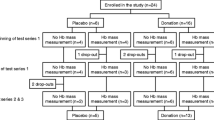Summary and Conclusions
Previous studies have shown that hard physical training first lowers, then gradually raises the total amount of hemoglobin. Variable results have been reported on the white blood cell count and the total plasma protein. This study was undertaken in an attempt to obtain progressive data on human subjects throughout an entire season of training for sports.
Three graduate students served as subjects. One underwent an extremely hard athletic training program. The second participated in a program of moderate intensity. The third subject served as a constant control.
No marked hematological changes related to the training program were observed in the subject undergoing a moderate athletic training program.
In the subject who underwent a hard athletic training program, the hemoglobin percentage showed an initial drop followed by a subsequent rise. A similar trend was observed in the hemoglobin per erythrocyte values. A slightly higher number of leucocytes was noted at the end of the training period. These changes are interpreted as caused by the physical training.
The differential white count and the total plasma protein showed no appreciable changes directly attributable to the training involved.
Similar content being viewed by others
References
Branwood, A. W.: Edinbgh. Med. J.53, 125 (1946).
Broun, G. O.: J. of Exper. Med.36, 481,37, 113, 187, 207 (1922–23).
Bryan, W. R., L. L. Castain andW. E. Garrey: Amer. J. Physiol.113, 430 (1935).
Cureton, T. K.: Physical Fitness of Champion Athletes. Urbana: The University of Illinois Press (1951).
Davis, J. E., andN. Brewer: Amer. J. Physiol.113, 586 (1935).
Egoroff, A.: Z. klin. Med.100, 484 (1924).
Ernst, H., andH. Herx-Heimer: Z. exper. Med.42, 107 (1924).
Ewig, W.: Z. exper. Med.61, 590 (1928).
Farris, E. J.: Amer. J. Anat.72, 223 (1943).
Fliegl, J., A. V. Knock andE. Koopmann: Biochem. Z.76, 88 (1916).
Ham, T. H.: A Syllabus of Laboratory Examinations in Clinical Diagnosis. Cambridge: Harvard University Press (1953).
Hawkins, C.: Unpublished dissertation, New York University, New York (1937).
Kjellberg, S., U. Rudhe andT. Sjoestrand: Acta physiol. scand. (Stockh.)19, 146 (1949).
Knehr, C. A., D. B. Dill andW. Neufeld: Amer. J. Physiol.136, 148 (1942).
Robinson, S., andP. M. Harmon: Amer. J. Physiol.132, 757 (1941).
Thörner, W.: Arbeitsphysiologie2, 116 (1930).
Thörner, W.: Arbeitsphysiologie19, 95 (1949).
Author information
Authors and Affiliations
Additional information
Formerly Fulbright Scholar 1953–54 at the University of Illinois from the Norwegian Research Council for Sciene and Humanities.
Rights and permissions
About this article
Cite this article
Andersen, K.L., Heusner, W.W. & Pohndorf, R.H. The progressive effects of athletic training on the red and white blood cells and the total plasma protein. Int. Z. Angew. Physiol. Einschl. Arbeitsphysiol. 16, 120–128 (1955). https://doi.org/10.1007/BF00693740
Received:
Issue Date:
DOI: https://doi.org/10.1007/BF00693740



